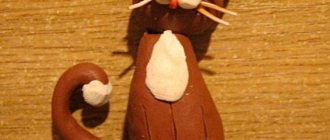Summary of an art lesson for the senior group “My favorite cat”
Potapova Elena Anatolyevna
Summary of an art lesson for the senior group “My favorite cat”
- expand knowledge about domestic animals;
- teach children to convey a familiar image of a domestic animal or cat in a drawing;
— consolidate skills in working with the end of a brush, painting skills when drawing.
2. Developmental
- develop visual skills and abilities, hand motor skills.
3. Educational
- cultivate independence and accuracy;
- cultivate a love for animals, a desire to care for them.
Preliminary work: reading poetry, fairy tales about cats, looking at illustrations, watching cartoons.
Educator: A guest came to our lesson today, and you can guess who!
Educator: Her name is Murka.
Guys, I met Murka this morning, near the kindergarten, so beautiful, she really wants to know everything about her cat history, and to look at other cats. Shall we help?
Educator: Children, which one of you have a cat at home?
-What color is she? (Children's answers)
Educator: Guys, people have many proverbs and folk beliefs about these amazing animals, let's remember them:
— The cat is washing itself and inviting guests.
- Cat out of the house - mice on the table.
— The cat hides its face in the face of frost or bad weather.
“You don’t pet a cat against its grain.”
- Cats fight, mice have fun.
- A kind word is also pleasant for a cat.
Educator: Well done, you know a lot of proverbs and folk signs!
Educator: Do you know how a cat became a pet?
For a very long time, cats have lived next to humans. In ancient times, cats were wild animals, people hunted them to get meat for food and skins. The homeland of the domestic cat is Africa.
This animal is independent, affectionate, gentle, and intelligent.
No two cats are the same. They differ from each other in the color of their fur and eyes, they have different characters. In addition, there are very fluffy ones - they are called long-haired, and there are smooth-haired ones.
The body of cats is flexible. With the help of their whiskers, they catch odors - besides, cats, and cats are excellent hunters, catch mice.
Educator: Do you guys want to draw a cat, a cat or a little kitten?
Let's take a little rest before work.
Physical school
The cat woke up this morning,
Practical part:
Educator: Now I will show you how we will draw a cat. Let's sketch the drawing with a simple pencil. Let's draw the torso and head.
Now let's finish drawing the ears, eyes, mustache, four paws and a long tail.
Choose the fur color for your animal yourself; it can be red, black, white, or gray.
Educator: Guys, where should we start coloring?
While you're drawing, give your cats a name.
Independent activity of children.
Educator: Guys, what did we talk about today?
Tell us what nicknames you came up with for them?
Lesson summary: What a great fellow you are! You all worked hard today, and you came up with very beautiful drawings - they will decorate our exhibition.
"Cat and kitten." A lesson for older children in the non-traditional drawing technique “Cat and Kitten.” The unusualness of this method lies in the fact that children are asked to paint with paints using a non-soft squirrel brush. Summary of an integrated lesson in the senior group “Cat with Kittens” Goal: To create conditions for successfully composing a story based on the painting “Cat with Kittens” using picture diagrams, continue to teach symmetrical.
How to draw a sitting cat
Representatives of the cat family are graceful in any position - lying down, jumping, sitting. The anatomy of this animal is unique - its skeleton has more bones than a human's.
How to draw a kisul with a pencil and convey in the process the elegance of movements and the naturalness of the pose? It is necessary to correctly determine the position of each part of the body relative to the others, to maintain their proportionality, observing proportions.
Step 1
Draw the cat's head in the shape of a circle, the body in the form of an elongated figure, curved in the middle, where the back is.
Step 2
Lightly outline the limbs and tail with curved lines. The animal's front legs are usually straight when sitting. The hind legs are bent in two places: in the area of the kneecap and where the shin bone meets the parts of the foot. In this lesson we will depict a cat washing itself, whose front paw is raised.
Step 3
Connect the head and neck. Add volume to the paws and tail in the right places. Mark the arch below the cat's withers. Draw the eyes, ears and mouth.
Step 4
Remove all unnecessary lines and adjust the figure if necessary.
Step 5
Add details to the image: draw pupils, claws, ears.
Step 6
Think about what pencil color you will choose for your cute character. It is interesting that only cats are tri-colored or tortoiseshell; cats with such a skin are extremely rare. The spots can be drawn arbitrarily; the stripes on animals are usually larger on the back and sides, and narrow on the face and paws.
Step 7
Color the image. When using blue, do not press on the pencil, use light shading, then these areas will appear snow-white.
Another option for drawing a cat
Non-traditional drawing in the senior group with wax pencils “Cat”
Svetlana Demidova
Non-traditional drawing in the senior group with wax pencils “Cat”
1. Strengthen drawing skills using an unconventional technique - wax pencils, which allows you to most clearly convey the depicted object, the characteristic texture of its appearance (volume, fluffiness)
2. Continue learning to draw large, position the image in accordance with the size of the sheet.
3. Expand knowledge about pets, instill love for them.
4. Develop children's creative imagination, create conditions for the development of creative abilities.
5. Develop visual skills and abilities, fine motor skills of the hands.
6.. Foster accuracy and independence;
7. Cultivate an emotionally positive attitude towards work.
Materials for the lesson : wax pencils, colored cardboard, PVA glue, hard brush, brush stand, wet wipe.
Preliminary work: watching cartoons, looking at illustrations, reading fiction about animals; games with cat toys, playing with them.
1. Move : Game “Hello, friend!”
Hello Friend! (Children stretch out their right hand to the side.)
Hello Friend! (Extend left arm to the side.)
Get in a circle quickly, (Hold hands.)
We'll go in a circle (They go in a circle.)
- Let's smile at each other and start our lesson. I want you to succeed and have a good mood all day!
- Guys, someone is coming to visit us. Want to know who it is? Then guess my riddle:
Indeed, a cat came to our group. Do you know her name? Her name is Murka. I met her this morning, near the kindergarten, so beautiful, elegant, but sad. It turns out she has no friends at all. When I found out this, I really wanted to help her. Guys, let’s help our Murka find friends together, but first I suggest cheering her up a little, playing the game “Cat Habits.”
How to draw a sleeping cat step by step
- Draw a large circle with a smaller circle inside it.
- Draw two small triangles to the inner circle. These will be our cat's ears.
- Inside the circle we decorate the eyes, nose and mustache. This is done using arcs, triangles and lines.
- Draw the tail. The drawing is ready.
Drawing of a cat in dynamics
Now let's make it more difficult. Try drawing a cat with a movement effect.
- Mark the general location of the cat with an oval on a piece of paper. Draw the head with a circle and the body with an oval. Use a horizontal line to mark the area on which the animal stands. Draw paws using strokes.
- Look in specialized literature to see what parts the cat's skeleton consists of. You will need this in order to show the cat in dynamics. Use dots to indicate the key proportions of the body. For example, the shoulder blade, hip and elbow. This will maintain the proportions of the animal's body.
- Outline the outline of the figure that characterizes the shape of our object (outline).
- Cover the drawing locally with black strokes. Mark the fur along the outline, using the technique of darker shading. This will help give the drawing a three-dimensional effect.
Let's draw a cat that sits with its head turned to one side.
We recommend starting this task by studying the step-by-step diagram.
- First draw a small circle that will symbolize the head. Draw a larger circle next to it. This will be the body of the cat.
- Inside both circles, draw auxiliary lines, and also mark the ears and tail.
- On the cat's face, draw eyes, a nose, a mouth and a mustache.
- Smoothly round the ears in the drawing, and make the outline of the head wavy. This technique will help to depict the wool from a more voluminous perspective.
- Using auxiliary lines, draw the back of the animal, as well as the front left paw and neck.
- Draw the tail. Erase the auxiliary lines.
Dear friends, in today's drawing lesson we learned how to draw a cat. Using a variety of techniques, you practiced creating pictures of animals from a variety of angles. We started our excursion into the world of artists with simple elements.
Using basic geometric shapes, our young artists learned to draw a cat sleeping peacefully on the sofa. After mastering basic drawing skills, we depicted a cat that woke up and was sitting by a bowl of milk.
After that we watched the cat hunt for mice. Our little artists immediately came up with the idea of drawing a cat in motion. Following a simple algorithm, they successfully completed the task.
The final task for our lesson today was to draw a cat sitting with its head turned to one side. Using all the accumulated knowledge, the novice artists depicted the cat in this position.
With this, our lesson for today can be considered completed. We are sure that children and their parents received a lot of new impressions for future discoveries. See you again, friends!







